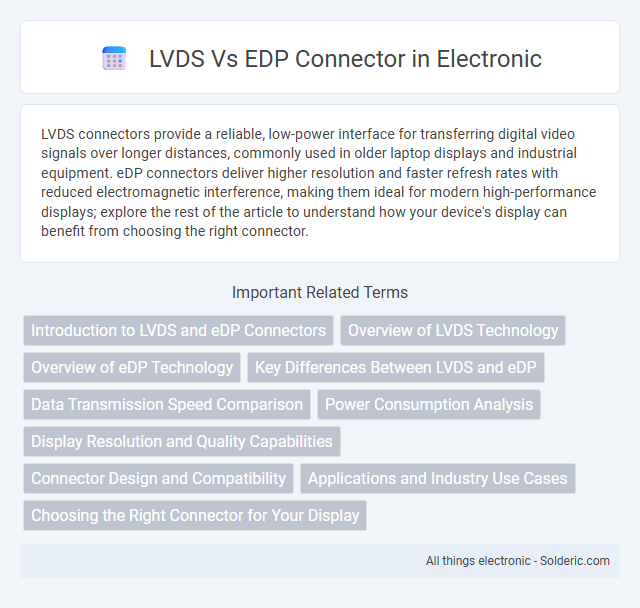LVDS connectors provide a reliable, low-power interface for transferring digital video signals over longer distances, commonly used in older laptop displays and industrial equipment. eDP connectors deliver higher resolution and faster refresh rates with reduced electromagnetic interference, making them ideal for modern high-performance displays; explore the rest of the article to understand how your device's display can benefit from choosing the right connector.
Comparison Table
| Feature | LVDS Connector | eDP Connector |
|---|---|---|
| Full Name | Low-Voltage Differential Signaling | Embedded DisplayPort |
| Usage | Laptop screens, industrial displays | Modern laptops, tablets, high-resolution panels |
| Data Transmission | Serial, differential signaling, limited bandwidth (~1.3 Gbps per lane) | High-speed packet-based, up to 8.1 Gbps per lane |
| Resolution Support | Up to 1920x1200 typically | Supports 4K and beyond |
| Connector Type | Flat cable with 20-30 pins | Flat cable or embedded board-to-board, fewer pins |
| Power Consumption | Moderate | Lower power, optimized for mobile |
| Video Signal Type | Analog-like differential signaling | Fully digital, packet-based |
| Compatibility | Legacy systems, older displays | Newer devices, high-resolution displays |
| Advantages | Simple design, cost-effective | Higher bandwidth, better power efficiency, supports multi-stream |
| Disadvantages | Lower bandwidth, limited resolution scaling | More complex, costlier implementation |
Introduction to LVDS and eDP Connectors
LVDS (Low-Voltage Differential Signaling) and eDP (Embedded DisplayPort) connectors serve as critical interfaces in display technology, enabling high-speed data transmission between the motherboard and display panel. LVDS connectors utilize differential signaling to reduce electromagnetic interference and are traditionally favored in older laptop screens and industrial applications. eDP connectors offer enhanced bandwidth and power efficiency, supporting higher resolutions and refresh rates, making them the preferred choice for modern high-definition displays.
Overview of LVDS Technology
LVDS (Low-Voltage Differential Signaling) technology enables high-speed data transmission with minimal electromagnetic interference by utilizing differential pairs that carry low-voltage signals. Commonly employed in flat-panel displays, LVDS connectors support resolutions up to Full HD (1920x1080) and maintain signal integrity over longer cable lengths compared to single-ended signaling. LVDS remains favored for cost-effective, reliable display interfaces, particularly in industrial and automotive applications where robustness is critical.
Overview of eDP Technology
eDP (Embedded DisplayPort) technology provides a high-speed digital interface designed specifically for internal laptop and tablet displays, delivering superior image quality with lower power consumption compared to LVDS (Low-Voltage Differential Signaling). Its ability to support higher resolutions, faster refresh rates, and reduced cable complexity makes eDP the preferred choice for modern display connectors. You benefit from enhanced performance and energy efficiency when using eDP over legacy LVDS interfaces.
Key Differences Between LVDS and eDP
LVDS (Low Voltage Differential Signaling) uses multiple pairs of differential signals for transmitting video data with lower power consumption and EMI, primarily in older laptop displays, whereas eDP (Embedded DisplayPort) employs a higher bandwidth, packet-based signaling protocol allowing for faster data transfer and support for higher resolution and refresh rates in modern screens. eDP connectors typically feature fewer pins compared to LVDS, simplifying design and enabling thinner, lighter devices. Understanding these key differences helps you choose the appropriate interface for your display technology requirements.
Data Transmission Speed Comparison
eDP connectors support significantly higher data transmission speeds compared to LVDS, with eDP capable of handling bandwidths up to 25.92 Gbps, enabling ultra-high-resolution displays and faster refresh rates. LVDS typically maxes out around 3.2 Gbps, making it suitable for lower-resolution screens and standard refresh rates. Choosing an eDP connector enhances your device's display performance with faster, more efficient data transfer.
Power Consumption Analysis
LVDS connectors typically consume more power due to their differential signaling over multiple twisted pairs at higher voltage levels, leading to increased energy usage in both signal transmission and the associated driver circuitry. eDP connectors are designed with advanced low voltage signaling standards that significantly reduce power consumption, making them more efficient for modern high-resolution display panels. Your choice between LVDS and eDP directly impacts power efficiency, especially in battery-operated devices where eDP offers notable energy savings.
Display Resolution and Quality Capabilities
LVDS connectors support display resolutions typically up to 1920x1080 (Full HD), making them suitable for standard definition and mid-range displays with moderate color depth. eDP connectors, however, enable higher resolution displays, such as 4K UHD (3840x2160) and beyond, delivering superior image clarity, faster refresh rates, and enhanced color accuracy. Your choice between LVDS and eDP will significantly impact display quality, especially in applications demanding high resolution and vivid visual performance.
Connector Design and Compatibility
LVDS connectors feature a bulkier design with multiple pins arranged to support differential signaling over longer distances, making them ideal for older or industrial display interfaces. In contrast, eDP connectors are more compact, employing fewer pins with high-speed serial data transmission optimized for slim laptops and modern displays, enhancing compatibility with current thin and light devices. Understanding your device's design requirements ensures choosing the connector that best matches your display's compatibility and performance needs.
Applications and Industry Use Cases
LVDS connectors are widely utilized in automotive displays, industrial machinery, and medical equipment due to their robust signal integrity and long-distance transmission capabilities. eDP connectors dominate the laptop and tablet markets, providing high-resolution video interfaces with reduced power consumption and thinner cable profiles ideal for portable devices. Manufacturing sectors prioritize LVDS for rugged environments, while consumer electronics favor eDP for sleek, high-performance display integration.
Choosing the Right Connector for Your Display
Choosing the right connector for your display involves weighing factors like signal quality, resolution support, and cable length. LVDS connectors offer robust performance for lower resolutions and longer cable distances, making them suitable for industrial and legacy applications. eDP connectors provide higher resolutions, faster refresh rates, and support for thinner, lighter designs ideal for modern laptops and high-definition screens, ensuring your display setup meets performance and design requirements.
LVDS vs eDP connector Infographic

 solderic.com
solderic.com